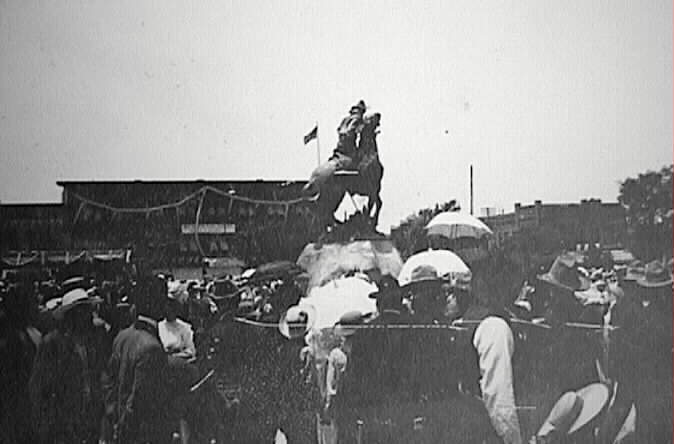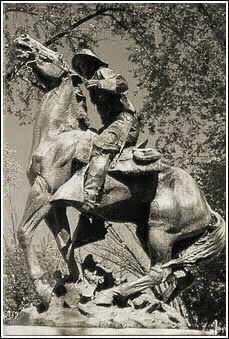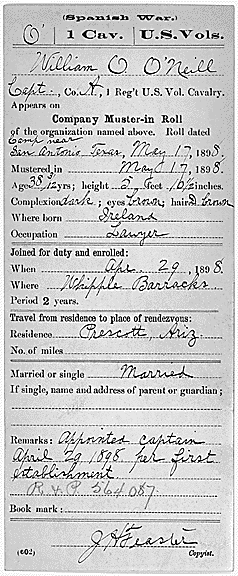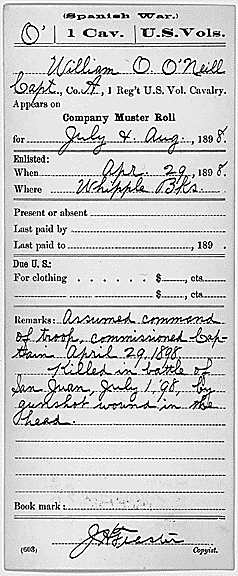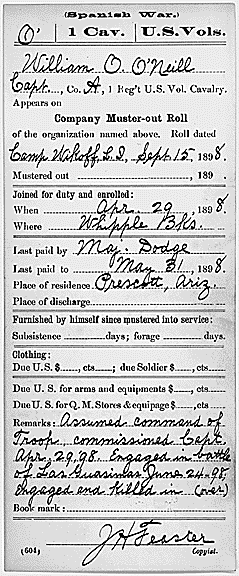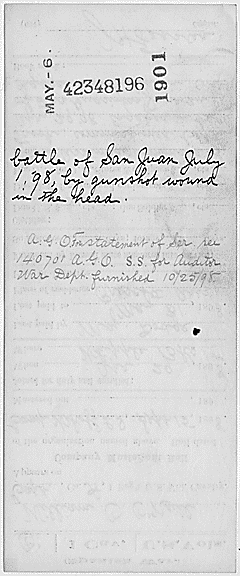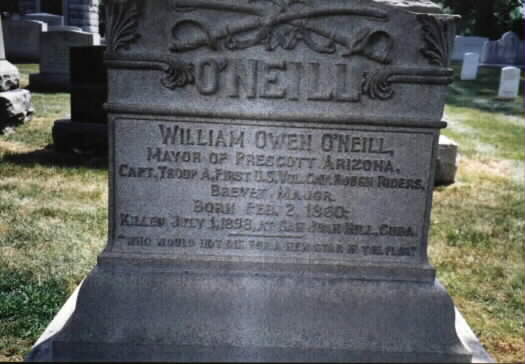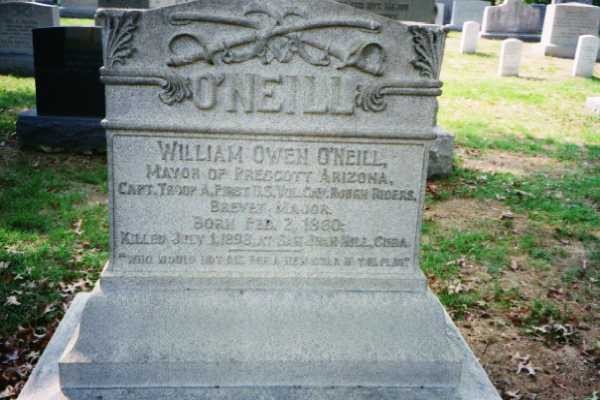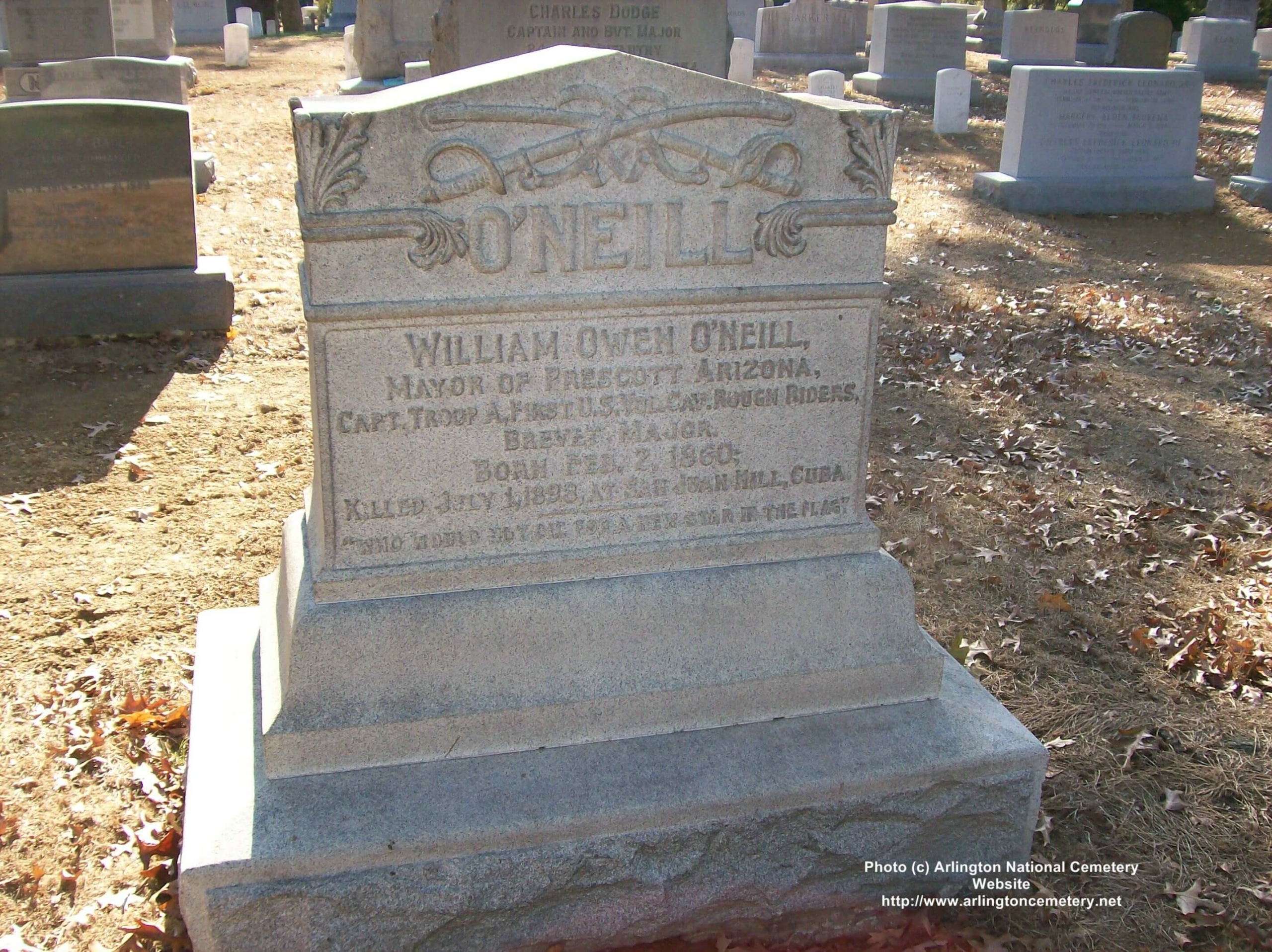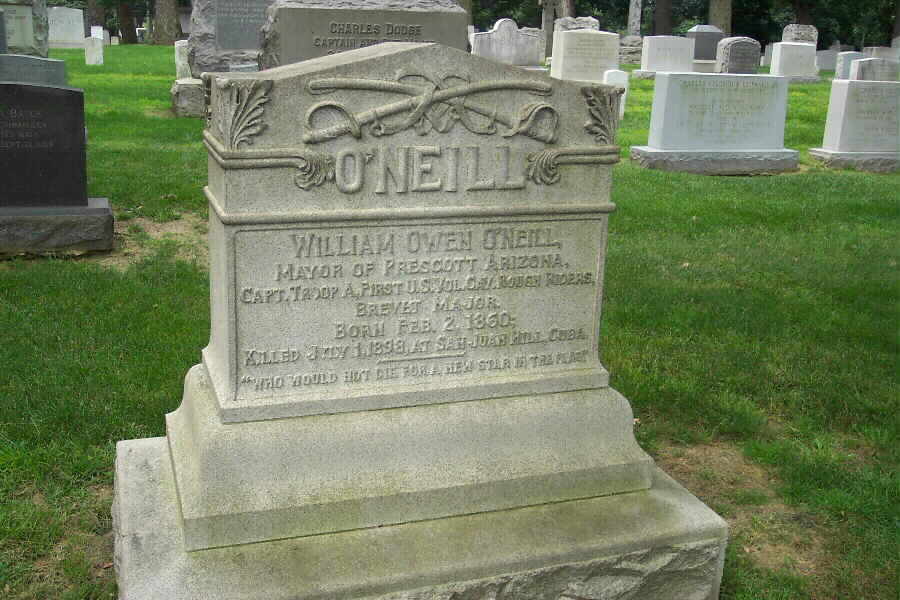Born on February 2, 1860 in St. Louis, Missouri, he moved East with his mother and brothers and graduated from the National Law School in Washington, D.C.
Later, out of 72 applicants for Assistant Paymaster of the United States Navy, he passed at the head of the class. There was some delay in making the appointment and O'Neill, chafing for some action, went to Arizona where, at different periods, he edited the Arizona Miner, Phoenix Herald and the Hoof and Horn, a cattleman's organ.
He was selected as judge of Yavapai County, Arizona, due to the trust that local residents placed in his honesty and integrity. He was subsequently elected Sheriff for three consecutive terms and while in that office demonstrated his courage and fearlessness. He was reportedly the best-armed man in the Territory and the best shot.
Finally, after many ups and downs with desperate charges and five fights with six-shooters, in which he was a terror to law-breakers, he retired as Sheriff and moved to Prescott, Arizona, where he ran three times for Congress, being defeated in each instance by a small majority.
He then ran for Mayor of Prescott and was elected unanimously.
When the Spanish-American War broke out he had been living a quiet and somewhat uneventful life. When Teddy Roosevelt's regiment was being formed, nearly 300 cowboys, miners, citizens and politicians joined with him and they rode to San Antonio, Texas and were received with open arms. This group became Troop A, 1st United States Volunteer Cavalry (Rough Riders).
He was killed-in-action on July 1, 1898 and it was written that:
“He was a brave fighter who displayed great gallantry and unfortunately lost his life in the battle for San Juan, Cuba.”
On his tomb in Section 1 of Arlington National Cemetery are the words that he had once written:
“Who would not die for a new star on the flag.”
Reverend Henry A. Brown, Rough Rider Chaplain, came to Prescott's St. Luke's Episcopal Church in 1897, where he was active in raising money for the Cuban cause. Brown performed Captain O'Neill's burial service, and, in 1899, went back to Cuba to retrieve O'Neill's body which was reinterred at Arlington National Cemetery. After the war he remained in the army as a Chaplain.
September 18, 1898
CAPTAIN “BUCKY” O'NEILL
How The ex-Mayor and Rough Rider Met His death
The late Captain O'Neill, of Troop A, First United States Volunteer Cavalry, was one of the most striking among the many odd characters from all walks of life which went to make up the famous regiment of Rough Riders. A plainsman, a legislator, a notorious gambler, an able economist, and a man devoid of fear, he earned a distinction in the combination of traits which it may be said none of his comrades reached. The account of his death was related the other day by a member of his troop who passed through Long Island City and his way South after being mustered out.
This was William Pulsing, a German-American business man of New Orleans, who was accepted into the regiment largely on account of his regular army experience. Mr. Pulsing was found at the Red Cross Hospital at Long Island City, where he was staying overnight, though little the worse for his campaign experiences. “Bucky O'Neill,” said he, “won his nickname from the fact that he was always given to “bucking” every gambling game in sight. He was noted through a large part of the West for his gambling propensities.
“Troop A, of which he was Captain, was not engaged at El Caney, but took part in the general advance on Santiago. He lost his life at the Battle of San Juan Hill. The troop was deployed along the creek, and the fire was hot. I asked Captain O'Neill if he would allow me to go ahead and reconnoitre, and on receiving permission, I started out and ran into a road a short distance ahead, which had been sunk by the use of troops and wagons, about a foot below the surrounding soil. I reported to Captain O'Neill that this would be a good place for the troop to find temporary shelter and we all went forward. The members of the troop lay down on this road.
“The Mauser bullets were whizzing rapidly over us, but Captain O'Neill, who was always accustomed to expose himself recklessly to fire, stood upright, apparently unconscious of danger. He was talking to an Adjutant General, though who the General was I don't know. Suddenly a Mauser bullet struck him squarely in the mouth, going in so evenly that his teeth weren't injured. He fell to the ground at once, and I am a man named Boyle, who was afterward killed inbattle, picked him up and carried his body to the rear. He died there in a few seconds.
“Captain O'Neill was noted for his writings on political economy besides his gambling tendencies. He was the Mayor of Phoenix, Arizona, when he enlisted, and was the first man to intruduce the theories of Henry George into that town. He never preached single tax in the regiment, however.”
Theodore Roosevelt, “The Rough Riders”
“The most serious loss that I and the regiment could have suffered befell just before we charged.
“Bucky O'Neill was strolling up and down in front of his men, smoking his cigarette, for he was inveterately addicted to the habit. He had a theory that an officer ought never to take cover — a theory which was, of course, wrong, though in a volunteer organization the officers should certainly expose themselves very fully, simply for the effect on the men; our regimental toast on the transport running, “The officers; may the war last until each is killed, wounded, or promoted.” As O'Neill moved to and fro, his men begged him to lie down, and one of the sergeants said, “Captain, a bullet is sure to hit you.” O'Neill took his cigarette out of his mouth, and blowing out a cloud of smoke laughed and said, “Sergeant, the Spanish bullet isn't made that will kill me.”
“A little later he discussed for a moment with one of the regular officers the direction from which the Spanish fire was coming. As he turned on his heel a bullet struck him in the mouth and came out at the back of his head; so that even before he fell his wild and gallant soul had gone out into the darkness.”
Thursday Morning, July 4, 1907
Tribute to Gallant Heroes!
Arizona Honors Bucky O'Neill and the Rough Riders
Nine years ago, July 1 as the American, soldiers, members of the Rough Riders, lay entrenched before San Juan Hill, awaiting the order from their superior to charge the foe, there walked back and forth, before his men, a Captain of one of the troops of that famous fighting command, who, despite the repeated entreaties of his followers, would not seek shelter from the rain of Spanish bullets that swept down the, hill.
Airily he smoked his cigarette, and glanced, ever, and anno, up the hill at the fortifications, with a supreme contempt for the poor marksmanship displayed by the Spaniards.
Not that he did hot realize the danger to which he was exposed; no man there knew better the meaning of a leaden bullet than he who so bravely faced the pitiless fire without flinching, or without thought of personal danger.
“Captain, please seek shelter; please lie down in the trenches,” begged one of his men, a sergeant.
“Sergeant,” replied, this brave soldier, who had but one thought in his mind at that time, hit country and his flag, “the Spanish bullet is not made that can kill me.”
And again he resumed his walking, up and. down in front of his men.
That man was, “Bucky” O'Neill, Arizona's hero. Brave, chivalrous, adventurous Captain William Owen O'Neill, in command of Troop A, Rough Riders.
Hardly had the reckless, slightly boasting words passed his lips, than Buckeye O'Neill fell, struck by the bullet he bad so shortly be derided. The leaden missile of death entered his mouth and fore derided it passed out at the rear of his head, and before his stalwart frame sank trembling to the ground his gallant soul had gone forth, to its maker.
Just nine years and three days after that event there was unveiled, yesterday, in the” plaza of the beautiful little mountain city be over whose mayor called home, and the time he gave up his life for his country's flag, a beautiful equestrian statue, as a tribute to the memory of a man who, today, is revered by every true Arizonan, and whose memory is kept green in the hearts of all those who knew him in life.
A fitting tribute, and one well deserved.
As the various speakers at yesterday's exercises extolled the; virtues of Prescott's patriot, tears filled the eyes of many: of those who had known him in days gone by, and who had been proud to call him friend, and a great pity welled lip into the hearts of the rugged, honest, God-fearing Arizonans that he was not still with them in the flesh.
With impressive ceremonies the draperies were pulled “aside from Borglum's beautiful statue, revealing the gallant captain, mounted on his charger. With distended nostrils the horse stands slightly reared back on his, haunches as though abruptly pulled up, while his rider, with face turned towards the left, sits in an attitude of expectancy, as though awaiting orders. It is a beautiful piece of craftsmanship, one well worthy of its subject.
Beneath the statue, forming its pedestal, is a gigantic boulder, weighing twenty-eight tons, secured from one of the neighboring mountains, which Buckeye loved so well in life. It remains in the rough, just as it was brought from the mountainside, carrying out the Rough Rider idea.
Many weary days were spent by Contractor H. C. Walter and men, in transporting the boulder to its present resting place. it was tedious work, owing to the cumberousness of the granite rock, but no work was too tedious for those who knew to what purpose the stone was to be put. Finally it was embedded on a cement foundation in the city plaza, and all was in readiness for the mounting of the statue, which at that time had not yet arrived.
As time wore on and the statue, which was somewhere on the roan, enroute here from New York, did not arrive, grave fears were entertained that it would not arrive in time for the unveiling ceremonies to take place on the date arranged. Then it was
demonstrated that railroads are not always the “soulless corporations” the muck-rakers like to picture them, and that a thread of sentiment, even like that which runs through the beings of everyday mortals, is present also in the make-up of the directors of the railroad systems.
W. A. Drake, vice president of the S. P., P. & P. railway, was appealed to to secure some trace of the statue and rush It through. He immediately set to work, and obtaining the co-operation of H. G. Wells of the coast lines of the Santa Fe,
dispatched a special a out on the road to look up the statue and rush It through at all hazard. This special agent was given the power to spare neither time nor expense in securing trace of the statue and getting it here on time. He found it buried in the yards at Albuquerque, N. M., and ordered it out on the first train leaving, in accordance with the orders of his superior officers. He rode with the train. At Winslow; the car In which the statue was loaded got out of repair, and lit the ordinary course of events the car would have been sidetracked and had to wait for the next train. This was no ordinary occasion, however, and the train was held several hours while all the mechanics obtainable were set to work repairing the car.
At Ash Fork a special engine was in waiting to bring the car here, and, last Saturday it arrived, having made the trip from Albuquerque here in record time.
The “Work of mounting It on the pedestal was accomplished In “the next two days, and yesterday the heroic bronze MOM was unveiled.
Fitting it was that Maurice O'Neill, adopted son of the deceased hero, and Miss Kite Hickey, daughter of Buckeye O'Neill's bosom friend in the days when the country was young, and history was warm in, the making, should have been delegated as the persons to actually unveiled the monument to the gaze of the
populace.
When the veilings inside and the beautiful bronzes statue stood revealed, a mighty from the hundreds assembled, and with bared heads, while the band played “America.” Those present did homage to the memory of brave Buckeye O'Neill.
William Owen O'Neill was born in St. Louis, Missouri, February 2, 1860. As a boy, he hunted squirrels — never dreaming that a marble stone would one day mark the spot of his last remains or the grounds where he first learned to use a gun.
The call of the West was too strong for the young lawyer to resist. Even the Army had to wait while he answered the call of the Last Frontier. Brushing aside a military career at West Point, he arrived in Prescott in 1881. His paper, the “Horn and Hoof,” published for the stockmen of the Territory, held many of his literary efforts.
It is interesting to note his aggressive and enthusiastic nature extended even to “Bucking the Tiger” as the game of Faro was called. It was not with the intention of labeling him as a chronic gambler that his friends nicknamed him “Bucky,” but in admiration of his tenacity.
He started his political career as probate judge, then he was sheriff of Yavapai County, and finally he became the mayor of Prescott.
It is said that he was the first to offer his service to his country in the Spanish-American War. He resigned as mayor and immediately began to form a cavalry regiment of Arizona men. He had enrolled 1,000 men, however only 210
had been allotted to Arizona.
“Bucky” O'Neill was made Captain, and on May 4, 1898, the men assembled at Whipple Barracks to leave for San Antonio, Texas for regimental rendezvous.
In San Antonio, he was given command of Troop A, which became part of the First United States Volunteer Cavalry. A remark by Colonel Theodore Roosevelt to a newspaper reporter saying he was going to Texas to join a regiment of rough riding men gave the name that has gone down in history. From then on, the regiment was called “Roosevelt's Rough Riders.”
To Bucky O'Neill, it was a short but meteoric path from mayor of Prescott to San Juan Hill. It was there that he was fatally wounded on July 1, 1898.
One year later, on May 1, 1899, “Bucky” O'Neill was laid to rest with the nation's honored dead at Arlington. Exactly nine years from the anniversary of his death, a bronze statue was dedicated to his memory at the Courthouse Plaza in Prescott.
BURIAL OF CAPTAIN O'NEILL
WASHINGTON, May 1, 1899 – The body of Captain William O. O'Neill of the Rough Riders was interred at Arlington National Cemetery today. He was buried just in front of the grave of Captain Allyn Capron who, like Captain O'Neill, lost his life in the Santiago campaign.
Military records courtesy of the National Archives
O'NEILL, WILLIAM
CAPT CO A 1ST U S V CAV
DATE OF DEATH: 07/01/1898
BURIED AT: SECTION 1 SITE 294
ARLINGTON NATIONAL CEMETERY
Michael Robert Patterson was born in Arlington and is the son of a former officer of the US Army. So it was no wonder that sooner or later his interests drew him to American history and especially to American military history. Many of his articles can be found on renowned portals like the New York Times, Washingtonpost or Wikipedia.
Reviewed by: Michael Howard

